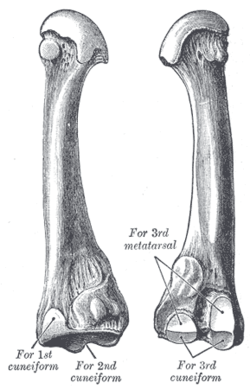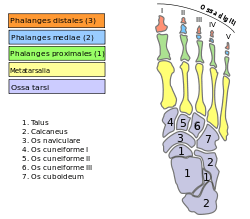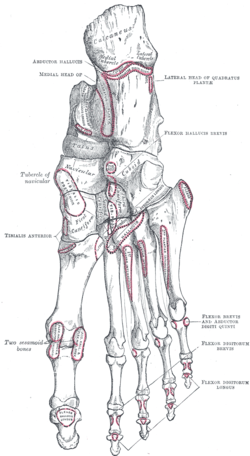Second metatarsal bone
| Second metatarsal bone | |
|---|---|
 | |
| The second metatarsal. (Left.) | |
 | |
| Bones of the right foot. Dorsal surface. Second metatarsal bone is the yellow bone second from the left | |
| Latin | Os metatarsale II |
| Gray's | p.273 |
| FMA | FMA:24503 |
The second metatarsal bone is a long bone in the foot. The second metatarsal bone is the longest of the metatarsal bones, being prolonged backward and held firmly into the recess formed by the three cuneiform bones.[1] The second metatarsal forms joints with the second proximal phalanx (a bone in the second toe) through the metacarpophalangeal joint, the cuneiform bones, third metatarsal and occasionally the first metatarsal bone.
As the four other metatarsals bone it can be divided into three parts; base, body and head. The base is the part closest to the ankle and the head is closest to the big toe. The narrowed part in the middle is referred to as the body of the bone. The bone is somewhat flattened giving it two sides; the plantar (towards the sole of the foot) and the dorsal side (the area facing upwards while standing).[1]
Its base is broad above, narrow and rough below.
It presents four articular surfaces: one behind, of a triangular form, for articulation with the intermediate cuneiform bone; one at the upper part of its medial surface, for articulation with the medial cuneiform; and two on its lateral surface, an upper and lower, separated by a rough non-articular interval. Each of these lateral articular surfaces is divided into two by a vertical ridge; the two anterior facets articulate with the third metatarsal; the two posterior (sometimes continuous) with the lateral cuneiform. A fifth facet is occasionally present for articulation with the first metatarsal; it is oval in shape, and is situated on the medial side of the body near the base.
The second metatarsal base acts as a "keystone" (like in an arch) for the lisfranc joint.
Muscle attachments
 Muscle attachments (seen from above) |  Muscle attachments (seen from below) |
The first and second dorsal interossei muscles attaches to the second metatarsal bone. The first dorsal interossei from the medial side of the bone and the second dorsal interossei from the lateral side. The function of the muscle is to spread the toes.[2]
The horizontal head of the adductor hallucis also originates from the lateral side of the metacarpophalangeal joint and from the deep transverse metatarsal ligament,[2] a narrow band which runs across and connects together the heads of all the metatarsal bones.
| Muscle | Direction | Attachment[3] |
| Dorsal interossei I | Origin | Medial side of the second metatarsal |
| Dorsal interossei II | Origin | Lateral side of the second metatarsal |
| Horizontal head of adductor hallucis | Origin | Deep transverse metatarsal ligament and the metacarpophalangeal joint |
Related Conditions
The second metatarsal bone elongation is distinctive feature of Morton's Toe (or Morton's foot). Morton's toe is a normal variation of second metatarsal and about 25% of total population has elongated second metatarsal bone. Although normal, Morton's toe causes extra-inversion of the foot and thereby puts more stress on lateral part of meniscus of the knee, promotes lordosis of lower back(lumbar spine) and kyphosis of neck(cervical spine). Symptoms include backpain, knee pain & arthritis of early age, constant tenderness of shoulder, both acute & chronic torticollis, headache and up to vague non-specific bodyaches.
Injuries
The Beckham bone is a name attributed by British journalists to the second metatarsal.
David Beckham, while playing for Manchester United against Deportivo La Coruña in a UEFA Champions League quarter-final game in 2002, was subject to a tackle from Argentina's Aldo Duscher. (A lot of acrimony had existed between David Beckham and Argentina since David Beckham's sending off in the 1998 World Cup). This tackle broke the second metatarsal in his left foot and seriously threatened England's chances in the 2002 World Cup. David Beckham was the media darling at the time, and the bone (and the tackle) received a wave of publicity; subsequently, the name "Beckham bone" was born.
Since then, other notable football players including, Daniel Agger, Gary Neville, Danny Murphy, Michael Owen, Gaël Clichy, Ashley Cole, Ledley King, Mikaël Silvestre, James Mathias and Lionel Messi have suffered fractures to the same 2nd metatarsal bone.
Additional images
-

Skeleton of foot. Medial aspect.
-

Oblique section of left intertarsal and tarsometatarsal articulations, showing the synovial cavities.
-

Bones of foot
-

Foot bones - tarsus, metatarsus
-

Foot bones - metatarsus and phalanges
-

Metatarsus
References
- ↑ 1.0 1.1 Bojsen-Møller, Finn; Simonsen, Erik B.; Tranum-Jensen, Jørgen (2001). Bevægeapparatets anatomi [Anatomy of the Locomotive Apparatus] (in Danish) (12th ed.). p. 246. ISBN 978-87-628-0307-7.
- ↑ 2.0 2.1 Bojsen-Møller, Finn; Simonsen, Erik B.; Tranum-Jensen, Jørgen (2001). Bevægeapparatets anatomi [Anatomy of the Locomotive Apparatus] (in Danish) (12th ed.). pp. 300–301. ISBN 978-87-628-0307-7.
- ↑ Bojsen-Møller, Finn; Simonsen, Erik B.; Tranum-Jensen, Jørgen (2001). Bevægeapparatets anatomi [Anatomy of the Locomotive Apparatus] (in Danish) (12th ed.). pp. 364–367. ISBN 978-87-628-0307-7.
This article incorporates text from a public domain edition of Gray's Anatomy.
| Wikimedia Commons has media related to Second metatarsal bone. |
| ||||||||||||||||||||||||||||||||||||||||||||||||